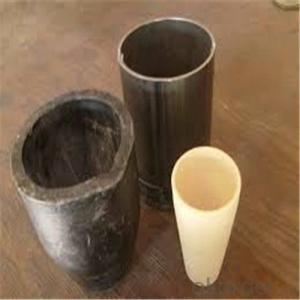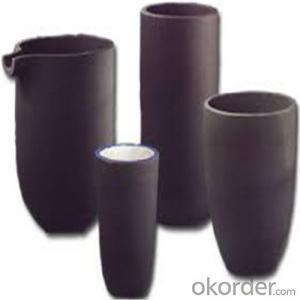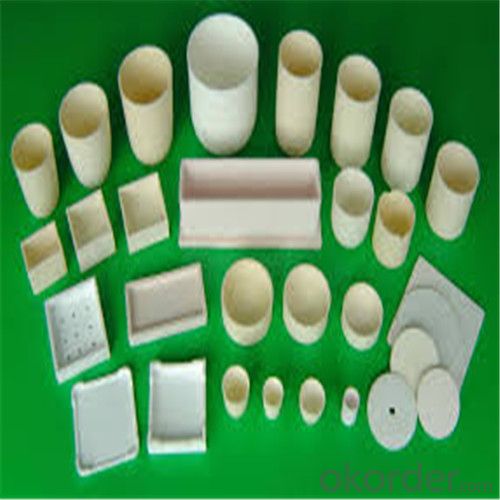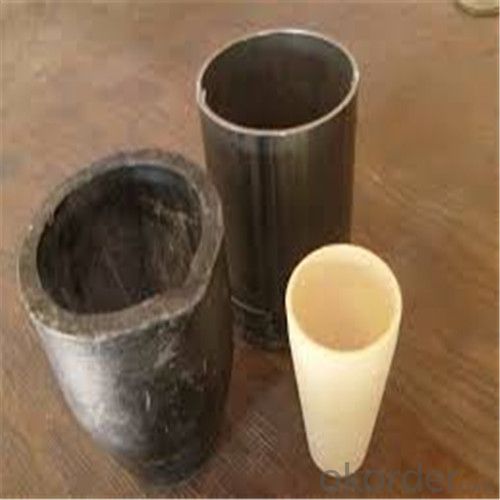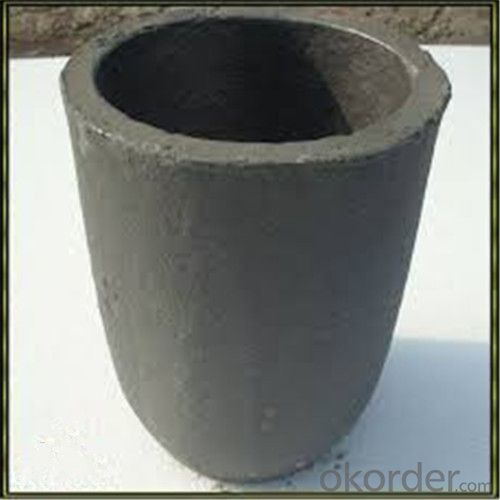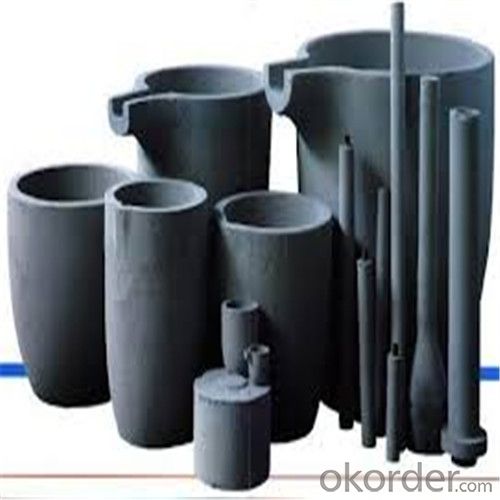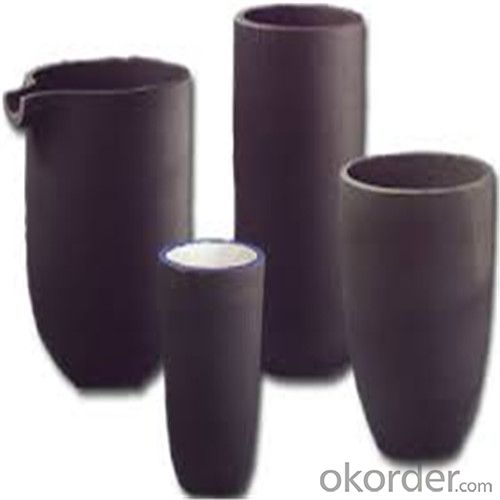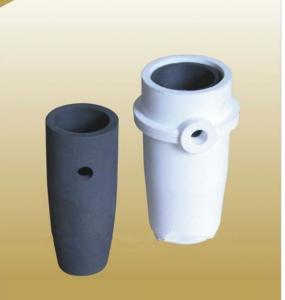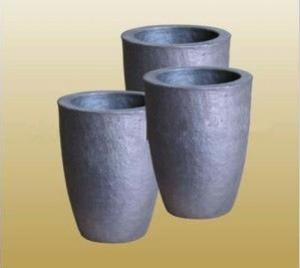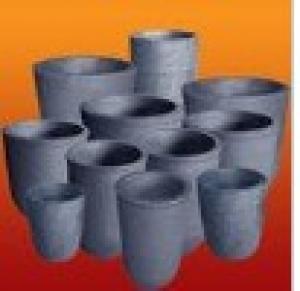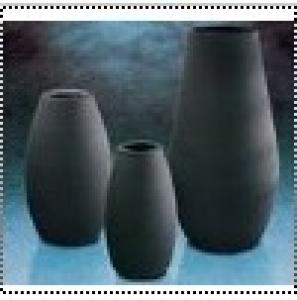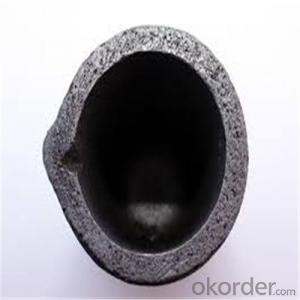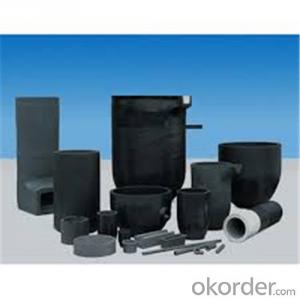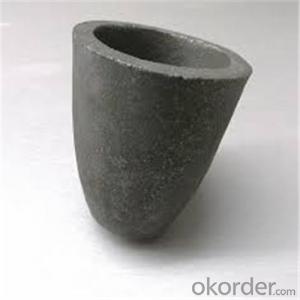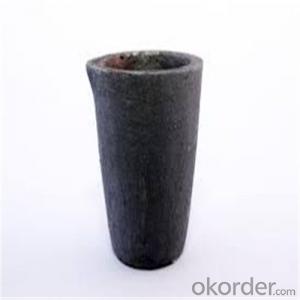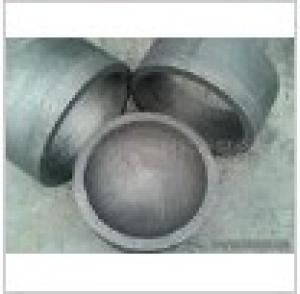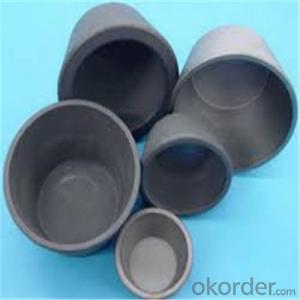Graphite Vs Ceramic Crucible - SIC Graphite Crucibles for Melting Aluminium, Copper, Brass 2024
- Loading Port:
- Shanghai
- Payment Terms:
- TT OR LC
- Min Order Qty:
- 1 pc
- Supply Capability:
- 1000 pc/month
OKorder Service Pledge
OKorder Financial Service
You Might Also Like
Quick Details for SiC Graphite Crucibles For Gold, Melting Aluminium And Copper, Brass
| Type: | High Strength, graphite crucible crucible | Application: | melting metal | Height: | as your requirements |
| Composition: | High Pure | Top Diameter: | 10-600mm | Bottom Diameter: | 10-1000mm |
| Place of Origin: | China (Mainland) | Brand Name: | Model Number: | ||
| Color: | Black grey | Si3N4%: | 5min | Fe2O3%: | 0.7max |
| C%: | 30-45 | Apparent porosity: | 30max | Refractoriness: | 1680 |
| Bulk Density: | 1.71min | Using life: | >5000 hours | MAX temperature: | 1600c |
Packaging & Delivery
| Packaging Details: | Seaworty packing or as per customer's detail requirement of graphite crucible. |
| Delivery Detail: | within 20-30 days after confirm order of graphite cru |
SiC Graphite Crucibles For Melting Aluminium And Copper, Brass
Product Description
Specifications for Graphite Silicon Carbide Crucible For Aluminum Melting :
1.Long working lifetime: its working lifetime is increased 3-5 times over normal clay-crucible due to the compact body formed under high pressure.
2.High thermal conductivity: high-density body and low apparent porosity greatly improve its heat conductivity.
3.New-style materials: new heat conduction material ensures faster heat conductivity and pollution-free product, reduces adherent slag.
4.Resistance to corrosion:better anti-corrosion than normal clay-crucible.
5.Resistance to oxidation: advanced process dramatically improves its oxidation resistance, which ensures persistent heat conductivity and long working lifetime.
6.High-strength: high-density body and logical structure make the product better compression property.
7.Eco-friendly: energy-efficient and pollution-free, not only ensure metal product purity, but also ensure sustainable development on environment.
8.Multi-function: Can be used in induction graphite crucible furnace
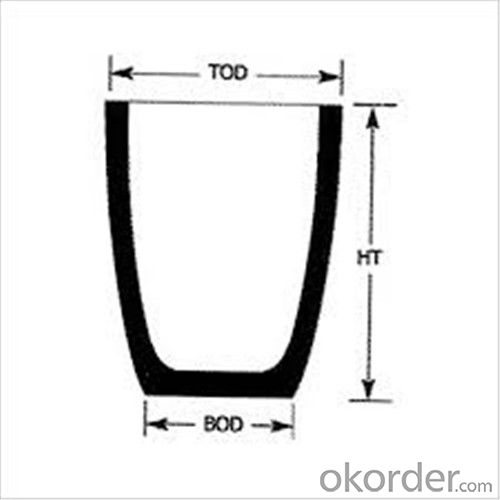

Physicochemical Properties of graphite crucible:
The crucible is an utensil or melting tank vessels that is made of refractory material (such as clay, graphite, quartz or difficult molten metal iron, etc.).
Graphite crucible, with is special advantages and Plasticity, is widely used in the smelting area, e.g. gold smelting, silver smelting, aluminum smelting, cooper smelting, etc.
high pure graphite | ||||
Item | Unit | baked twice | baked three time | baked four times |
impregnated once | impregnated twice | impregnated three times | ||
grain size | mm | ≤325μm | ≤325μm | ≤325μm |
Bulk density | g/cm3 | ≥1.68 | ≥1.78 | ≥1.85 |
Specific resistance | μΩ.m | ≤14 | ≤14 | ≤13 |
Bending strength | MPa | ≥25 | ≥40 | ≥45 |
Compressive strength | MPa | ≥50 | ≥60 | ≥65 |
Ash content | % | ≤0.15 | ≤0.1 | ≤0.05 |
Fine-grain Specialty Graphite FXG-1 | Fine-grain Specialty Graphite FXG-2 | ||||
Item | Unit | Guarantee value | Typical value | Guarantee value | Typical value |
Max grain size | mm | 0.8 | 0.8 | 0.8 | 0.8 |
Bulk density | g/cm3 | ≥1.70 | 1.73 | ≥1.73 | 1.76 |
Specific resistance | μΩ.m | ≤8.5 | 7.5 | ≤8.0 | 7 |
Bending strength | MPa | ≥10.0 | 11 | ≥12.0 | 12.5 |
Compressive strength | MPa | ≥24.0 | 27 | ≥31.0 | 34 |
Thermal Condcutivity | W/(m.k) | ≥120 | 150 | ≥130 | 160 |
C.T.E.(100-600) °C | 10-6/°C | ≤2.5 | 2.2 | ≤2.5 | 2.1 |
Ash content | % | ≤0.3 | 0.09 | ≤0.3 | 0.09 |
NO | Top diameter | Bottom diameter | Height | Tolerance | Capacity(Kg5%) |
2 | 90 | 50 | 55 | 2 | 0.3 |
3 | 105 | 80 | 93 | 2 | 0.5 |
4 | 102 | 80 | 100 | 2 | 0.6 |
5 | 112 | 82 | 130 | 2 | 0.8 |
6 | 120 | 82 | 141 | 2 | 0.9 |
8 | 138 | 90 | 153 | 2 | 1.2 |
12 | 148 | 100 | 181 | 2 | 1.8 |
16 | 156 | 110 | 190 | 2 | 2.3 |
20 | 180 | 120 | 230 | 2 | 3 |
25 | 186 | 128 | 248 | 2 | 3.7 |
- Q: What are the main changes in graphene supercapacitors?
- The advent of graphene supercapacitors, the first change is electronic products and digital products, why do you say so? Because the ultracapacitor is obviously charging and discharging faster. So, for example, mobile phone charging, electric cars, electric cars, computers and other products will decline in price. The birth of super capacitors indicates that mobile phones can become thinner and smaller, because the space that the battery takes can be smaller.
- Q: Can graphite crucibles be used for catalyst preparation?
- Catalyst preparation can indeed make use of graphite crucibles. Given their exceptional thermal conductivity and resistance to thermal shock, graphite crucibles are frequently employed in high temperature scenarios. They are able to endure temperatures of up to 3000°C, rendering them well-suited for multiple catalyst preparation methods that necessitate high temperatures. Graphite crucibles furnish a steady and unreactive setting for catalyst synthesis and preparation. They do not readily interact with most chemicals, enabling compatibility with a wide array of catalyst materials and precursors. This facilitates effective catalyst synthesis without the risk of impurities or undesired reactions. Moreover, graphite crucibles are renowned for their durability and lengthy lifespan, making them a cost-effective choice for repetitive use in catalyst preparation. They can be effortlessly cleaned and reused, thereby reducing the overall expenditure of the catalyst preparation process. It is important to note that the selection of crucible material may be contingent upon the specific catalyst preparation process and the chemicals involved. While graphite crucibles generally prove suitable for numerous catalyst preparation applications, some highly reactive or corrosive chemicals may necessitate the use of alternative crucible materials, such as ceramic or quartz crucibles. Consequently, it is crucial to consider the specific requirements of the catalyst preparation process before opting for a particular crucible material.
- Q: Are graphite crucibles suitable for melting superalloys?
- Graphite crucibles are well-suited for the melting of superalloys due to their high melting point and excellent thermal conductivity. They are ideal for applications requiring elevated temperatures. Superalloys, known for their exceptional heat resistance and mechanical strength, often necessitate extreme temperatures for melting. Graphite crucibles can endure these high temperatures without deteriorating, ensuring a stable and reliable melting process for superalloys. Moreover, graphite crucibles exhibit good chemical resistance, which is crucial when melting superalloys that may contain reactive elements or corrosive impurities. In summary, graphite crucibles are widely favored in the aerospace, automotive, and manufacturing sectors for melting superalloys due to their durability, ability to withstand high temperatures, and chemical resistance.
- Q: What is the typical weight of a graphite crucible?
- The typical weight of a graphite crucible can vary depending on its size and intended use. However, on average, graphite crucibles range from a few hundred grams to several kilograms in weight.
- Q: Does the graphite pan need preheating?
- 5. the use of coke block size is less than the furnace wall and the crucible spacing should be added since the 5 fall, not ramming.6. crucible before use for 1-1.5 hours from the gas warm up to 200 degrees Celsius (especially in the initial drying must be in a continuous turning of the crucible and the crucible, slowly warming up and down at the same time and shall not exceed 100 degrees, to be slightly cooler, water vapor discharged after 1 hours) and then continue to heat up. The temperature to about 800 DEG C, baking time not too long. (such as spalling, improper preheating burst, not a quality problem, if the company is not responsible for the return. 7.) must keep the inside wall intact, to avoid bias by.8. flame burner flame heating, don't direct injection in the crucible, should be sprayed on the seat and into the crucible.9. proposed to use.10. into the metal crucible clamp corresponding to the bottom and then insert the scrap metal ingot, but not too close to the edge and, in order to avoid fragmentation through the use of a.11. crucible crucible best due to the expansion of metal Continuous melting, reduce the interval time.12. if intermediate stop using the remaining liquid should be dry, in order to avoid cracking caused by the continued use of.13. in the smelting process, must strictly control the amount of refining agent, added in excess, will reduce the service life of the crucible. And often clean ballast junction, guide and capacity to change the face of the impact of free crucible at the same time. Ballast too thick will cause the upper expansion.
- Q: What are the considerations for selecting a crucible stand for graphite crucibles?
- When selecting a crucible stand for graphite crucibles, there are several important considerations to keep in mind: 1. Material: The crucible stand should be made of a material that can withstand the high temperatures associated with graphite crucibles. Common materials used for crucible stands include stainless steel, cast iron, and ceramic. 2. Stability: The stand should be sturdy and stable to ensure that the crucible remains steady during the heating process. This is especially important when working with high temperatures or when conducting experiments that involve stirring or transferring materials. 3. Size and shape: The stand should be designed to accommodate the size and shape of the graphite crucible being used. It should provide a secure fit to prevent any movement or potential accidents. 4. Heat resistance: The stand should have good heat resistance properties to avoid any deformation or damage when exposed to high temperatures. It should be able to withstand the thermal expansion and contraction that occurs during heating and cooling cycles. 5. Support: The stand should provide adequate support for the crucible, ensuring that it is held securely in place. It should have a design that minimizes any potential contact between the crucible and the stand, reducing the risk of contamination. 6. Accessibility: The stand should allow for easy access to the crucible for loading and unloading materials. It should have a design that allows for easy handling and manipulation of the crucible, ensuring safety and efficiency during operations. 7. Compatibility: The stand should be compatible with the type of heating equipment being used. It should fit properly on the heating apparatus and be able to withstand the associated heat sources, such as Bunsen burners or electric furnaces. By considering these factors, one can select a suitable crucible stand that will ensure the safe and effective use of graphite crucibles in various applications, such as chemical analysis, metal casting, or laboratory experiments.
- Q: Can a graphite crucible be used for tin melting?
- Indeed, tin melting can be accomplished using a graphite crucible. In numerous high-temperature scenarios, such as metal melting, graphite crucibles find extensive utilization. Due to its exceptional heat resistance and elevated melting point, graphite is well-suited for both containment and endurance of the extreme temperatures required for tin melting. Furthermore, graphite exhibits commendable thermal conductivity, facilitating the attainment of uniform heat distribution throughout the melting procedure. Consequently, when it comes to melting tin, a graphite crucible proves to be a fitting selection and is widely employed in foundries and metallurgical industries for this very purpose.
- Q: Are there any safety precautions to take when using a graphite crucible?
- There are various safety measures that need to be taken into account when utilizing a graphite crucible. To start with, it is crucial to handle the crucible with caution and avoid any instances of dropping or striking it against hard surfaces. Graphite crucibles are relatively delicate and can easily crack or break if handled improperly, which could result in harm or equipment damage. Moreover, it is imperative that graphite crucibles are stored in a dry and clean area in order to prevent contamination or chemical reactions. Moisture or impurities can cause the crucible to deteriorate or react with the heated materials, compromising its reliability and potentially causing accidents or failures. In addition, it is of utmost importance to utilize appropriate personal protective equipment (PPE) when working with a graphite crucible. This includes wearing heat-resistant gloves, goggles, and a lab coat or protective clothing to shield against heat and potential splashes or spills. When heating or cooling the crucible, it is advised to do so gradually in order to avoid thermal shock. Quick temperature changes can lead to the crucible cracking or breaking, posing possible danger or damage. Furthermore, it is essential to be mindful of the materials being utilized in the crucible. Certain substances may produce toxic fumes or hazardous reactions when heated in a graphite crucible, thus proper ventilation and knowledge of the materials' properties are crucial. Finally, after usage, it is vital to allow the crucible to completely cool down before handling or storing it. Attempting to handle a hot crucible can result in severe burns or injuries. By adhering to these safety precautions, the likelihood of accidents, injuries, or damage when utilizing a graphite crucible can be significantly diminished, ensuring a safe and efficient working environment.
- Q: Can quartz ceramic crucibles instead of graphite crucibles?
- For the time being, I don't know what to replace. Since graphite was chosen, nothing else could be used.
- Q: Is it possible to achieve a controlled atmosphere inside a graphite crucible?
- Yes, it is possible to achieve a controlled atmosphere inside a graphite crucible. Graphite crucibles are often used in high-temperature applications such as metallurgy and chemical processes. They have excellent thermal conductivity and can withstand extreme temperatures. To create a controlled atmosphere, various methods can be employed, such as using gas purging techniques or introducing specific gases into the crucible to create the desired environment. The ability to achieve a controlled atmosphere depends on the design and sealing capabilities of the crucible, as well as the specific requirements of the process being carried out.
Send your message to us
Graphite Vs Ceramic Crucible - SIC Graphite Crucibles for Melting Aluminium, Copper, Brass 2024
- Loading Port:
- Shanghai
- Payment Terms:
- TT OR LC
- Min Order Qty:
- 1 pc
- Supply Capability:
- 1000 pc/month
OKorder Service Pledge
OKorder Financial Service
Similar products
Hot products
Hot Searches
Related keywords

